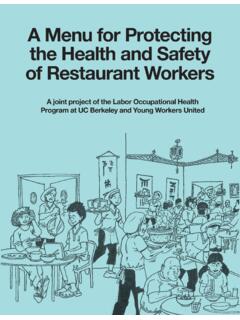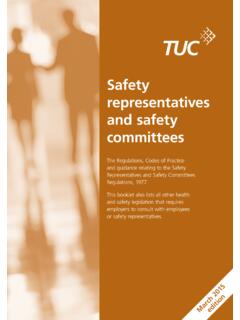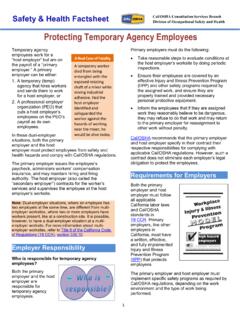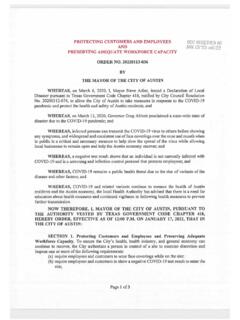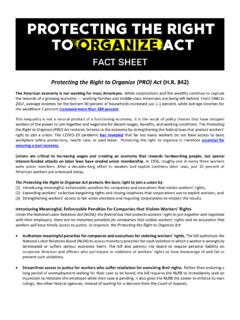Transcription of Safeguarding Equipment and Protecting Employees from ...
1 Safeguarding Equipment andProtecting Employees Business Safety andHealth Management SeriesOSHA 3170-02R 2007 Employers are responsible for providing a safe andhealthful workplace for their Employees . osha srole is to assure the safety and health of America semployees by setting and enforcing standards; pro-viding training, outreach, and education; establish-ing partnerships; and encouraging continual im-provement in workplace safety and publication is in the public domain and may bereproduced, fully or partially, without credit is requested, but not information is available to sensory impairedindividuals upon request. Voice phone: (202) 693-1999; teletypewriter (TTY) number: (877) 889-5627. Edwin G. Foulke, Secretary of Labor forOccupational Safety and HealthSafeguarding Equipmentand Protecting Employeesfrom AmputationsOccupational Safety and Health Department of LaborOSHA 3170-02R 20072 Occupational Safety and Health AdministrationThis osha publication is not a standard or regulation, and it creates no new legal obligations.
2 Thepublication is advisory in nature, informational in content, and is intended to assist employers inproviding a safe and healthful workplace. The Occupational Safety and Health Act requires employersto comply with hazard-specific safety and health standards. In addition, pursuant to Section 5(a)(1),the General Duty Clause of the Act, employers must provide their Employees with a workplace freefrom recognized hazards likely to cause death or serious physical harm. Employers can be cited forviolating the General Duty Clause if there is a recognized hazard and they do not take reasonablesteps to prevent or abate the hazard. However, failure to implement these recommendations is not,in itself, a violation of the General Duty Clause. Citations can only be based on standards, regula-tions, and the General Duty Standards 5 National Consensus Standards 6 Recognizing Amputation Hazards7 Hazardous Mechanical Components 7 Hazardous Mechanical Motions 7 Hazardous Activities 9 Hazard Analysis 9 Controlling Amputation Hazards9 Safeguarding Machinery 9 Primary Safeguarding Methods10 Guards10 Safeguarding Devices13 Secondary Safeguarding Methods16 Probe Detection and Safety Edge Devices 16 Awareness Devices17 Safeguarding Methods 17 Safe Work Procedures 18 Complementary Equipment 18 Administrative Issues 19 Inspection and Maintenance 19 Lockout/Tagout 20 Specific Machine Hazards andSafeguarding Methods20 Hazards of Mechanical Power Presses20 Safeguarding Mechanical Power Presses22 Other Controls for Mechanical Power Press Servicing and Maintenance23 Training24 Additional Requirements24 Power Press Brakes25 Hazards of Power Press Brakes25 Safeguarding Power Press
3 Brakes25 Other Controls for Power Press Brakes26 Hazards of Conveyors26 Safeguarding Conveyors28 Other Controls for Conveyors29 Hazards of Printing Presses30 Safeguarding Printing Presses31 Other Controls for Printing Presses32 Hazards of Roll-Forming and Roll-Bending Machines33 Safeguarding Roll-Forming and Roll-Bending Machines33 Other Controls for Roll-Forming and Roll-Bending Machines34 Hazards of Shearing Machines35 Safeguarding Shearing Machines36 Other Controls for Shearing Machines36 Hazards of Food Slicers37 Safeguarding and Other Controls for Food Slicers38 Hazards of Meat Grinders38 Safeguarding and Other Controls for Meat Grinders39 Hazards of Meat-Cutting Band Saws39 Safeguarding and Other Controls for Meat-Cutting Band Saws40 Hazards of Drill Presses41 Safeguarding and Other Controls for Drill Presses42 Hazards of Milling Machines43 Safeguarding and Other Controls for Milling Machines44 Hazards of Grinding Machines45 Safeguarding and Other Controls for Grinding Machines46 Hazards of Slitters46 Safeguarding and Other Controls for Slitters47 osha Assistance49 References51 Appendix Hazards Not Covered in this Guide53 Appendix Hazards Associated with Other Equipment and Activities54 Appendix Regional Offices55 Safeguarding Equipment AND Protecting Employees FROM AMPUTATIONS34 Occupational Safety and Health AdministrationList of TablesTable1.
4 Commonly Used Machine Guards 12 Table2. Types of Safeguarding Devices 13 List of FiguresFigure 1. Rotating Motion 7 Figure 2. Reciprocating Motion7 Figure 3. Transversing Motion7 Figure 4. Cutting Action7 Figure 5. Punching Action8 Figure 6. Shearing Action 8 Figure 7. Bending Action8 Figure 8. In-Running Nip Points 8 Figure 9. Fixed Guard on a Power Press 11 Figure 10. Power Press with an Adjustable Barrier Guard 11 Figure 11. Self-Adjusting Guard on a Radial Saw 11 Figure 12. Interlocked Guard on a Roll Make-up Machine 11 Figure 13. Pullback Device on a Power Press 13 Figure 14. Restraint Device on a Power Press 16 Figure 15. Presence-Sensing Device on a Power Press16 Figure 16. Two-Hand Control16 Figure 17. Power Press with a Gate16 Figure 18. Power Press with a Plunger Feed17 Figure 19. Shuttle Ejection Mechanism18 Figure 20.
5 Safety Tripod on a Rubber Mill18 Figure 21. Typical Hand-Feeding Tools19 Figure 22. Properly Guarded Foot Control 19 Figure 23. Part Revolution Mechanical Power Press with a Two-Hand Control21 Figure 24. Hand-Feeding Tools Used in Conjunction with Pullbacks on a Power Press 23 Figure 25. Power Press Brake Bending Metal 25 Figure 26. Two-Person Power Press Brake Operation with Pullbacks26 Figure 27. Belt Conveyor27 Figure 28. Screw Conveyor27 Figure 29. Chain Driven Live Roller Conveyor 27 Figure 30. Slat Conveyor28 Figure 31. Roll-to-Roll Offset Printing Press31 Figure 32. Sheet-Fed Offset Printing Press31 Figure 33. Roll-Forming Machine33 Figure 34. In-Feed Area of a Roll-Forming Machine33 Figure 35. Hydraulic Alligator Shear 35 Figure 36. Power Squaring Shear35 Figure 37. Meat Slicer37 Figure 38. Stainless Steel Meat Grinder38 Figure 39. Stainless Steel Meat-Cutting Band Saw40 Figure 40.
6 Drill Press with a Transparent Drill Shield41 Figure 41. Bed Mill43 Figure 42. Horizontal Surface Grinder45 Figure 43. Paper Slitter47 IntroductionAmputations are among the most severe and dis-abling workplace injuries that often result in perma-nent disability. They are widespread and involvevarious activities and Equipment . (The Bureauof Labor Statistics 2005 annual survey data indicat-ed that there were 8,450 non-fatal amputation cases involving days away from work for all privateindustry. Approximately forty-four percent (44%) ofall workplace amputations occurred in the manu-facturing sector and the rest occurred across theconstruction, agriculture, wholesale and retail trade,and service industries.) These injuries result fromthe use and care of machines such as saws, press-es, conveyors, and bending, rolling or shapingmachines as well as from powered and non-pow-ered hand tools, forklifts, doors, trash compactorsand during materials handling activities.
7 Anyone responsible for the operation, servicing,and maintenance (also known as use and care) ofmachines (which, for purposes of this publicationincludes Equipment ) employers, Employees ,safety professionals, and industrial hygienists should read this publication. Primary Safeguarding ,as used in this publication, includes control meth-ods that protect ( , prevent employee contactwith hazardous machine areas) Employees frommachine hazards through effective machine guard-ing techniques. In addition, a hazardous energycontrol (lockout/tagout) program needs to comple-ment machine Safeguarding methods in order toprotect Employees during potentially hazardousservicing and maintenance work activities. This guide can help you, the small businessemployer, identify and manage common amputa-tion hazards associated with the operation and careof machines. The first two sections of the document,Recognizing Amputation Hazards andControllingAmputation Hazards, look at sources of amputa-tions and how to safeguard machinery and controlemployee exposure to hazardous energy (lockout/tagout) during machine servicing and maintenanceactivities.
8 The section on Specific MachineryHazards and Safeguarding Methodsidentifies thehazards and various control methods for machineryassociated with workplace amputations, such as:mechanical power presses, press brakes, convey-ors, printing presses, roll-forming and roll-bendingmachines, shears, food slicers, meat grinders, meat-cutting band saws, drill presses, milling machines,grinding machines, and slitting machines. The information in this booklet does not specif-ically address amputation hazards on all types ofmachinery in general industry, construction, mar-itime and agricultural operations; however, manyof the described Safeguarding techniques may beused to prevent other amputation injuries. Ad-ditionally, while this manual concentrates attentionon concepts and techniques for safeguardingmechanical motion, machines obviously present avariety of other types of energy hazards that cannotbe ignored.
9 For example, pressure system failurecould cause fires and explosions. Machine electri-cal sources also pose electrical hazards that areaddressed by other osha standards, such as theelectrical standards contained in Subpart S. Fulldiscussion of these matters is beyond the scope ofthis publication. For compliance assistance purpos-es, references and the appendices are provided onapplicable osha standards, additional informationsources, and ways you may obtain osha StandardsAlthough this guide recommends ways to safeguardand lockout/tagout energy sources associated withmachinery hazards, there are legal requirements inOSHA standards that you need to know about andcomply with. The following osha standards are afew of the regulations that protect Employees fromamputation hazards. Machinery and Machine Guarding:29 CFR Part 1910, Subpart O Definitions General requirements for allmachines Woodworking machinery require-ments Abrasive wheel machinery Mills and calenders in the rubberand plastics industries Mechanical power presses Forging machines Mechanical power-transmissionapparatusControl of Hazardous Energy (Lockout/Tagout):29 CFR and Power Tools:29 CFR Part 1926, Subpart I General requirements Abrasive wheels and tools Mechanical power-transmissionapparatusConveyors:29 CFR Equipment AND Protecting Employees FROM AMPUTATIONS5 Concrete and Masonry Construction 29 CFR Part 1926, Subpart Q Requirements for Equipment andtoolsConsult these standards directly to ensure fullcompliance with the provisions as this publicationis not a substitute for the standards.
10 States withOSHA-approved plans have at least equivalentstandards. For detailed information about machineguarding and lockout/tagout, see the followingresources: Machine Guarding Safety and Health TopicsPage ( ) Machine Guarding eTool ( ) osha Publication 3067, Concepts and Techniquesof Machine Safeguarding ( ) osha Directive STD 01-05-019 [STD ],Control of Hazardous Energy (Lockout/Tagout) Inspection Procedures and Interpretive Guidance Control of Hazardous Energy (Lockout/Tagout)Safety and Health Topics Page ( ) osha s Lockout Tagout Interactive TrainingProgram ( ) osha Publication 3120, Control of HazardousEnergy (Lockout/Tagout) osha standards, directives, publications, and other resources are available online Consensus StandardsOSHA recognizes the valuable contributions ofnational consensus standards and these voluntarystandards may be used as guidance and recognitionof industry accepted practices.










